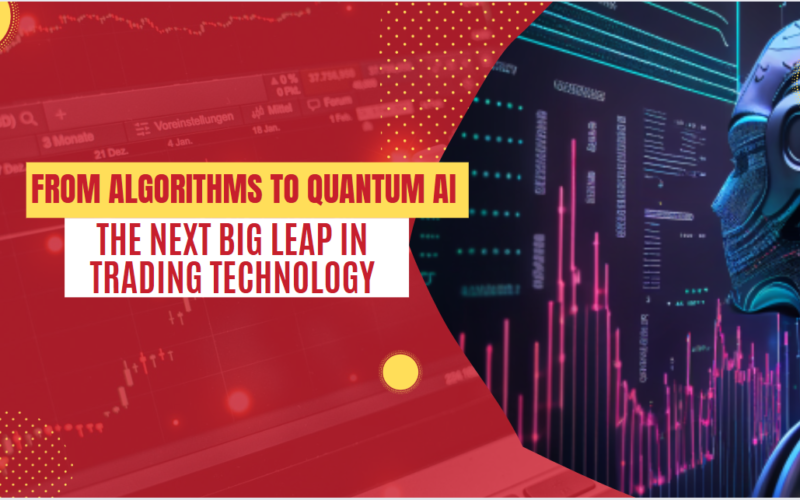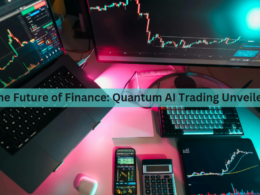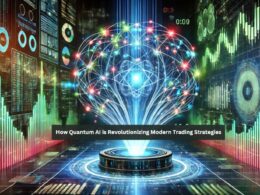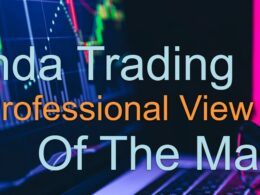The world of trading has undergone a massive transformation over the past few decades, evolving from human-driven decision-making to algorithmic and AI-powered strategies. What once relied on intuition, experience, and market analysis has now shifted toward automation, where high-frequency trading (HFT), machine learning, and artificial intelligence (AI) dominate the financial landscape. However, the journey doesn’t stop here.
The next big revolution in trading technology is the integration of Quantum AI – a fusion of quantum computing and artificial intelligence. This cutting-edge technology promises to process vast amounts of financial data at unprecedented speeds, making market predictions more accurate and efficient. As traditional algorithms reach their limits in handling market complexities, quantum computing offers a new dimension of possibilities, fundamentally changing how traders and institutions approach the financial markets.
In this article, we will explore the evolution of trading technology, the rise of algorithmic trading, the role of AI in market analysis, and the groundbreaking impact of Quantum AI. From enhanced risk management to near-instantaneous trade execution, we will uncover how this next leap in technology is set to reshape the future of trading.
The Role of Algorithms in Modern Trading
In today’s fast-paced financial markets, algorithms play a central role in executing trades with precision, speed, and efficiency. Algorithmic trading, also known as algo-trading or automated trading, relies on complex mathematical models and predefined rules to make real-time trading decisions without human intervention. This has significantly transformed the way markets operate, allowing traders to capitalize on price movements within fractions of a second.
How Algorithmic Trading Works
At its core, algorithmic trading uses programmed instructions based on various market factors such as price, volume, timing, and technical indicators. These algorithms analyze massive amounts of market data, identify profitable opportunities, and execute trades automatically. The key advantages of this system include:
- Speed – Algorithms can execute trades in milliseconds, far quicker than a human trader.
- Accuracy – By eliminating human emotions, algo-trading ensures precise execution based on data-driven strategies.
- Efficiency – Large volumes of trades can be executed simultaneously across multiple markets, optimizing opportunities.
- Cost Reduction – Automated trading minimizes transaction costs and reduces the need for manual oversight.
Types of Algorithmic Trading Strategies
Various strategies are used in algorithmic trading, each tailored to specific market conditions and objectives. Some of the most common include:
- High-Frequency Trading (HFT) – Uses ultra-fast algorithms to execute thousands of trades per second, profiting from tiny price fluctuations.
- Market Making – Involves continuously placing buy and sell orders to profit from the bid-ask spread.
- Arbitrage Trading – Exploits price differences of the same asset across different exchanges for risk-free profits.
- Trend Following – Identifies and follows long-term market trends using indicators like moving averages.
- Mean Reversion – Assumes that asset prices will revert to their historical average over time, allowing traders to buy low and sell high.
The Evolution and Limitations of Algorithmic Trading
While algorithmic trading has made markets more efficient, it also comes with challenges. The increasing reliance on automation has led to concerns about market stability, as seen in flash crashes, where rapid algorithmic trading causes sudden price collapses. Additionally, traditional algorithms, despite their speed, have limitations in adapting to unexpected market events or analyzing highly complex patterns.
This is where artificial intelligence (AI) and machine learning step in, enhancing algorithmic trading by making it more adaptive and intelligent. AI-driven models can learn from past market behavior, identify new patterns, and adjust strategies in real-time—laying the groundwork for the next evolution in trading technology. In the following section, we will explore how AI has further revolutionized trading by making it more predictive, efficient, and dynamic.
The Rise of Artificial Intelligence in Trading
As financial markets become more complex and data-driven, Artificial Intelligence (AI) has emerged as a game-changing force in trading. Unlike traditional algorithms that rely on predefined rules, AI-powered systems can analyze vast amounts of historical and real-time data, learn from market behavior, and adapt trading strategies dynamically. This shift has not only improved the accuracy of trade predictions but has also given traders a competitive edge in an increasingly volatile market.
How AI is Transforming Trading
AI in trading leverages advanced technologies such as machine learning (ML), deep learning, and natural language processing (NLP) to process massive datasets and extract meaningful insights. The key ways AI is revolutionizing trading include:
- Pattern Recognition – AI can identify hidden patterns and correlations in financial data that are impossible for humans or traditional algorithms to detect.
- Sentiment Analysis – Using NLP, AI scans news articles, financial reports, and social media to gauge market sentiment and predict potential price movements.
- Real-Time Decision Making – Unlike static algorithms, AI continuously learns from new data, adjusting trading strategies in real time to optimize performance.
- Risk Management – AI models assess portfolio risks dynamically, helping traders and institutions minimize losses and protect investments.
AI-Powered Trading Strategies
The integration of AI has led to the development of more sophisticated trading strategies that outperform traditional methods. Some of the most impactful AI-driven approaches include:
- Predictive Analytics – AI analyzes historical price data to forecast future price trends with higher accuracy.
- Reinforcement Learning – AI continuously refines trading strategies based on market feedback, improving decision-making over time.
- Deep Learning for Market Anomalies – Neural networks detect anomalies in market data, identifying potential trading opportunities.
- AI-Driven Arbitrage – AI systems scan multiple markets in real-time, executing trades instantly to capitalize on price discrepancies.
Challenges and Limitations of AI in Trading
While AI has significantly enhanced trading efficiency, it is not without its challenges. Some key limitations include:
- Data Quality Dependency – AI models require vast amounts of high-quality data for accurate predictions; poor or biased data can lead to incorrect decisions.
- Overfitting Risks – AI models trained on past market data may struggle to adapt to unprecedented events or market shocks.
- Regulatory Concerns – The increasing use of AI in financial markets raises ethical and regulatory challenges, as automated systems can potentially manipulate markets.
Despite these challenges, AI is continuously evolving, making trading more efficient, data-driven, and predictive than ever before. However, even AI has its limits when it comes to processing the complexities of financial markets. This is where the next frontier – Quantum AI Trading – comes into play, promising to take trading technology to an entirely new level. In the next section, we will explore how quantum computing is set to revolutionize financial markets and why it could be the most significant leap in trading technology yet.
Quantum AI – The Game Changer
As financial markets continue to evolve, even the most advanced AI models are facing limitations in processing the immense complexity of global trading. Traditional AI relies on classical computing, which, despite its speed, struggles with highly intricate calculations involving multiple variables and uncertainties. This is where Quantum AI steps in – a revolutionary fusion of quantum computing and artificial intelligence that has the potential to redefine trading technology.
What is Quantum AI?
Quantum AI combines the power of quantum computing – which operates on quantum bits (qubits) instead of classical binary bits—with machine learning and AI algorithms. Unlike traditional computers that process one calculation at a time, quantum computers can handle multiple calculations simultaneously, exponentially increasing processing power.
In trading, this means:
- Unprecedented Speed – Quantum AI can analyze massive amounts of financial data in nanoseconds, far surpassing conventional AI models.
- Enhanced Pattern Recognition – Quantum computing enables AI to detect complex patterns in the market that classical computers cannot.
- Superior Risk Analysis – Quantum AI can assess market risks with a higher degree of accuracy, considering multiple variables at once.
How Quantum AI is Revolutionizing Trading
Quantum AI is expected to transform trading in several key areas, including:
- Ultra-Accurate Market Predictions – Traditional AI models rely on historical data to forecast trends, but Quantum AI can simulate multiple market scenarios in real-time, improving prediction accuracy.
- Solving Optimization Problems – Portfolio optimization, risk assessment, and trade execution involve highly complex mathematical problems. Quantum AI can solve these in seconds, making decision-making faster and more efficient.
- Quantum Speed Arbitrage – Arbitrage opportunities exist when price differences occur across exchanges. Quantum AI can detect and execute these trades faster than any existing system.
- High-Frequency Trading (HFT) Evolution – HFT algorithms already operate at lightning speeds, but Quantum AI can take them to an entirely new level by executing trades with near-instantaneous precision.
Challenges and the Road Ahead
Despite its immense potential, Quantum AI is still in its early stages of development. Some key challenges include:
- Hardware Limitations – Quantum computers require specialized hardware and cooling systems, making them expensive and not yet widely accessible.
- Error Rates – Quantum systems are prone to quantum decoherence, where small disturbances can cause errors in calculations.
- Regulatory and Ethical Concerns – The ability of Quantum AI to execute trades at near-instantaneous speeds may raise concerns about market fairness and regulatory compliance.
The Future of Quantum AI in Trading
As quantum technology advances, financial institutions and hedge funds are investing heavily in Quantum AI research. In the coming years, we can expect hybrid trading models, where classical AI and Quantum AI work together to optimize trading strategies.
Quantum AI is not just an improvement—it is a paradigm shift that will redefine financial markets. With its ability to process information at speeds beyond imagination, Quantum AI has the potential to unlock new levels of trading efficiency, accuracy, and profitability. The next step is integrating this technology into real-world financial applications, a transition that will shape the future of trading as we know it.
Conclusion
The evolution of trading technology has been a journey of constant innovation, from rule-based algorithms to self-learning AI models and now the emerging power of Quantum AI. Each advancement has pushed the boundaries of market efficiency, speed, and predictive accuracy, transforming how financial institutions and traders operate.
Algorithmic trading revolutionized financial markets by enabling high-speed, automated decision-making. Artificial Intelligence took this a step further, introducing machine learning-driven models that could adapt to market changes and process vast amounts of data in real-time. However, even AI has its limitations when it comes to the complexity and unpredictability of global trading.
Quantum AI represents the next major leap, promising unmatched computational power and the ability to process intricate financial models instantaneously. With the potential to optimize portfolios, execute high-frequency trades at quantum speeds, and predict market movements with unprecedented accuracy, Quantum AI is set to redefine the financial landscape.
However, challenges remain. Scalability, hardware limitations, and regulatory concerns must be addressed before Quantum AI can become a mainstream trading tool. Despite these hurdles, financial institutions, hedge funds, and tech giants are already investing heavily in quantum research, signaling that the future of trading is closer than we think.
As we stand on the brink of this new era, one thing is clear—the fusion of AI and quantum computing will shape the future of financial markets, opening doors to possibilities beyond human imagination. The next big leap in trading technology is no longer a question of “if” but “when.”











